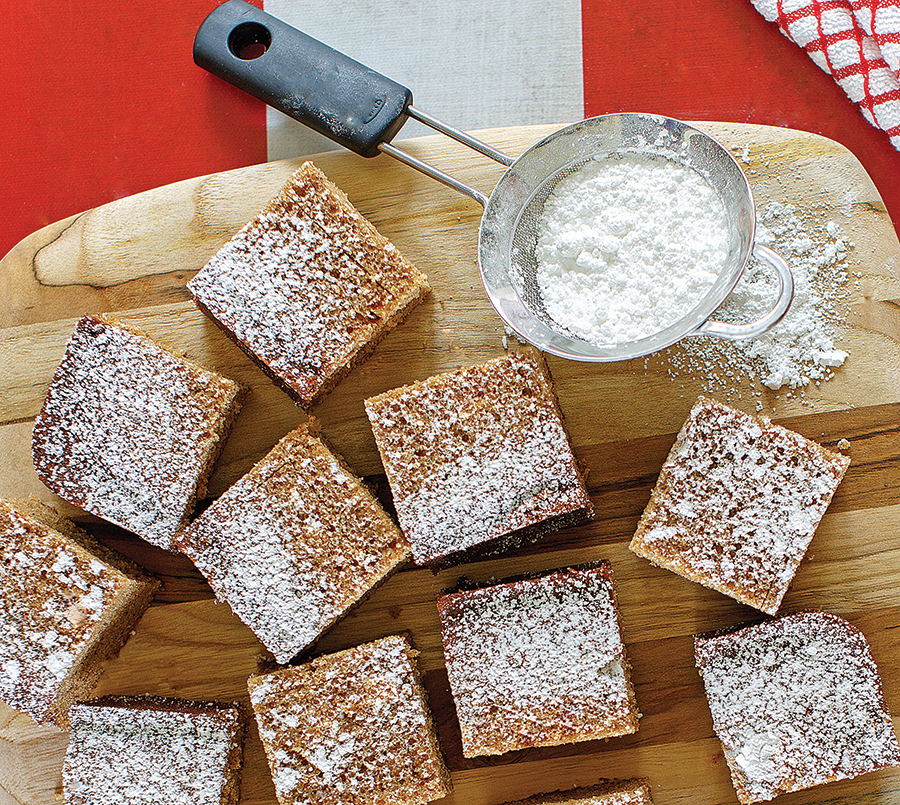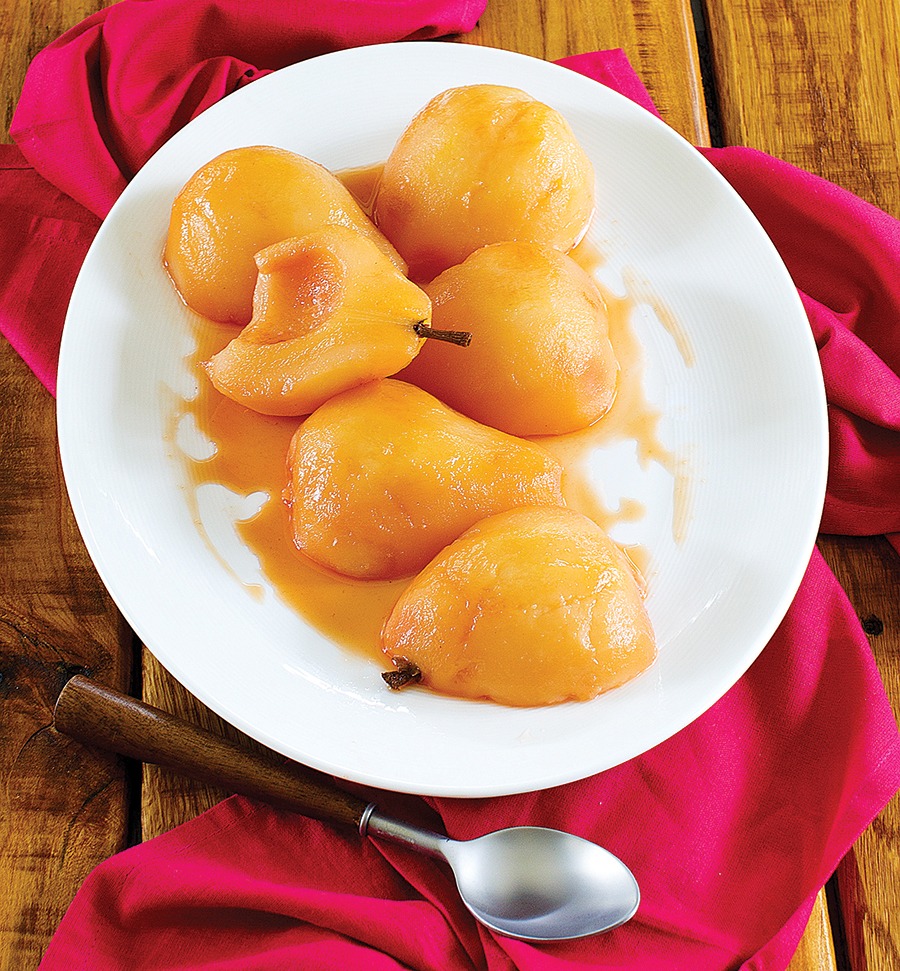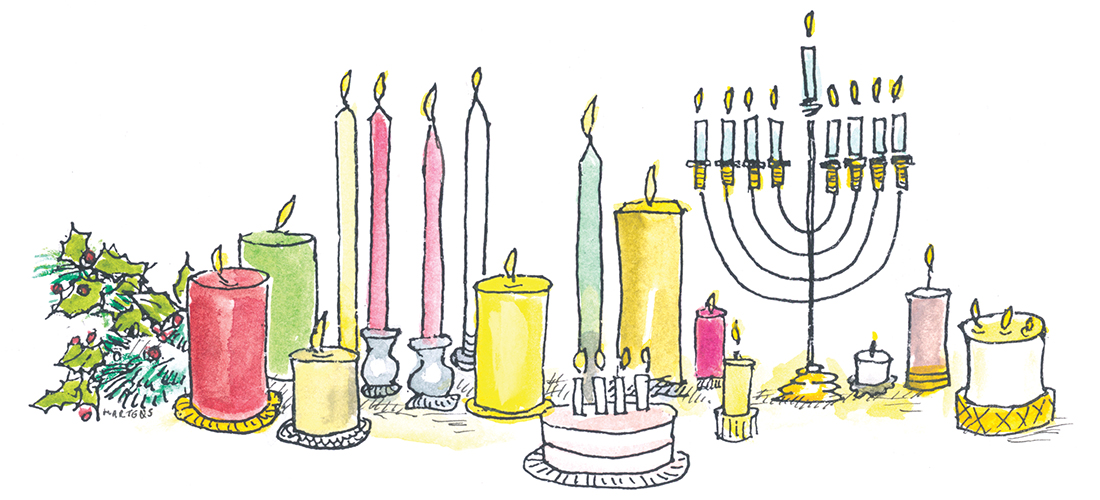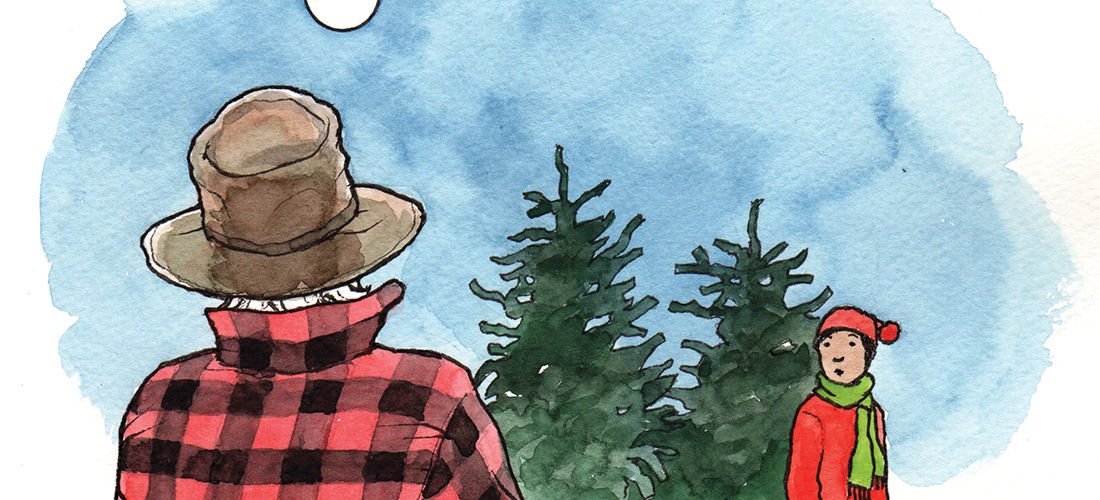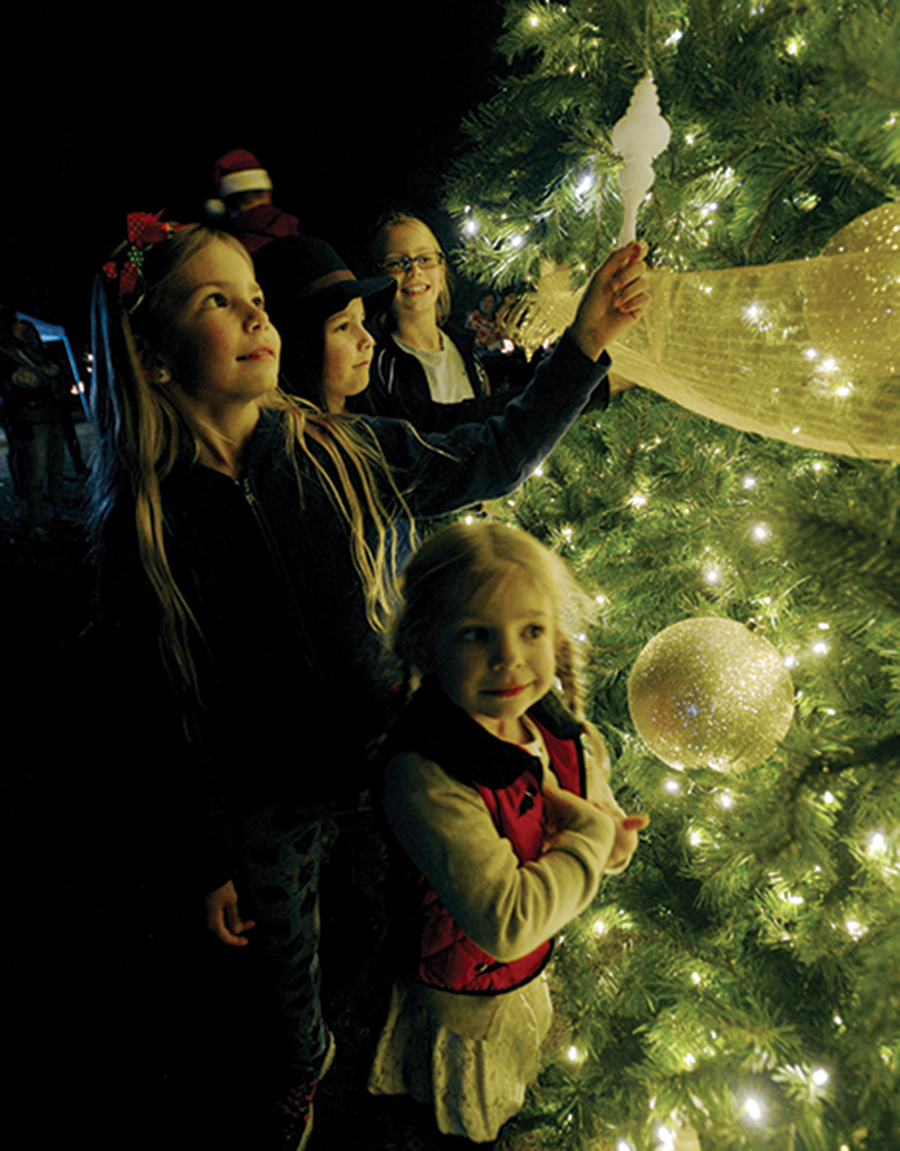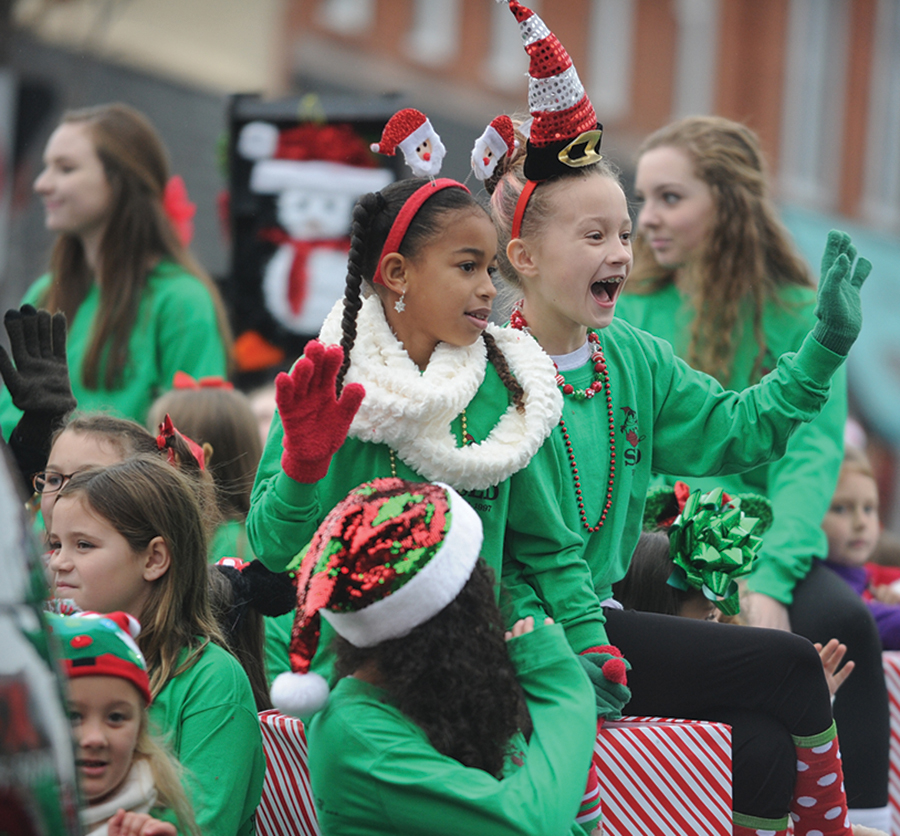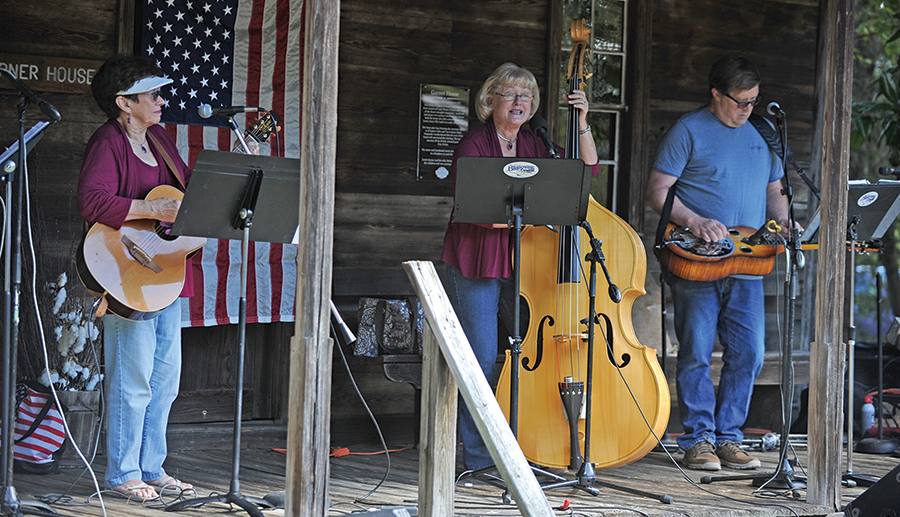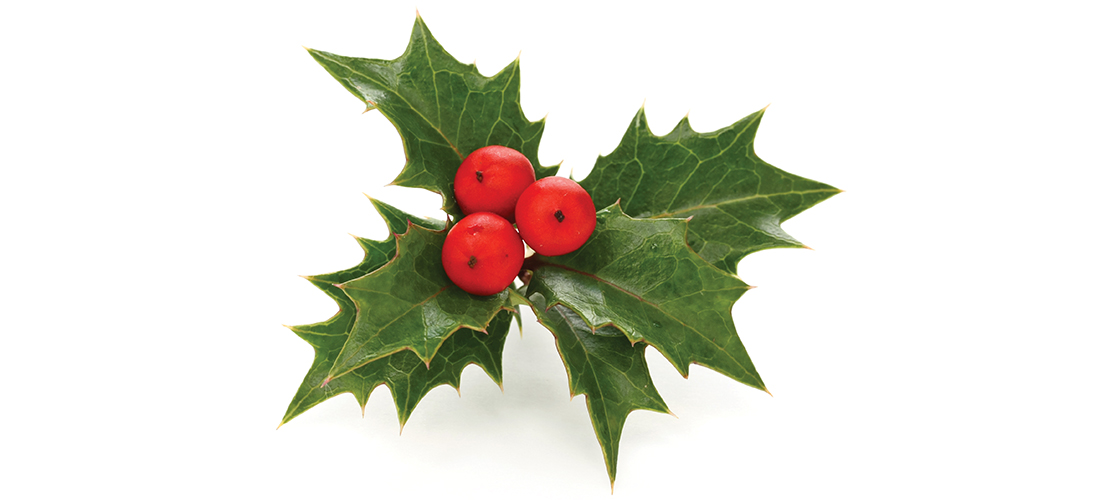Fiction by Bruce Shields • Illustrations by Harry Blair
In a small village, deep in a valley of the Great Smoky Mountains, freshly fallen snow glistened in the late afternoon light, blanketing the ground and adorning the firs and the cedars and the tall, stately pines. The sun cast long shadows across the snow, giving a warm, orange glow to all it touched. Horse-drawn sleighs glided along the streets, and bells on the harnesses jingled in the chilly air. Wreaths of green boughs with their red ribbons hung from the lamplights. Smoke wafted from the chimneys of the homes lining the streets, and festive lights sparkled from their windows. You could almost smell the gingerbread and hot apple cider.
High up on the mountainside, an old man looked down on the twinkling lights and curling smoke through passive gray eyes. He knew the joy and excitement the people were feeling at Christmas. He knew how the children’s eyes would sparkle as the families sat by their fires at night and talked of the days ahead. But for him, all that was many, many years ago — like another lifetime. Now his long hair and beard were white as the snow around him, and if any sense of joy or sorrow remained, the distant stare in his tired eyes gave no hint of what it might be.
His name was Samuel Cross, although most of the villagers knew him as Old Sam. He had lived alone in the mountains for as long as anyone could remember. He was a gentle recluse who seemed to want nothing more than to be left alone — with one exception. Each year, he brought the villagers their Christmas trees.
He grew the trees beside his mountain cabin, tending to them as though they were children of his own. Indeed, they were his family. When Christmas was a few days away, he would carefully select and cut the trees to load on his sleigh and sell in the village square. It was the only time he was ever seen by the villagers and, by Christmas Eve, he would be gone.
Old Sam spent the day cutting the trees, and with his sleigh piled high with the fragrant evergreens, he was ready to begin the long trip down the mountain. Just before he mounted his sleigh, he paused beside a small fir. It was no more than 3 feet tall, with a bent trunk that supported a few poorly arranged boughs. Although he normally left the smaller trees to grow for future years, something inside him said that he could not leave this one behind. He knelt beside it in the snow and carefully cut the trunk with his sharp axe. Then he carried the little tree to his sleigh and placed it on top of the others.
Sam climbed up onto the seat, gave the reins a snap and began his journey down the mountain. A full moon lit the way and, with a bed of fresh snow on the road, the old mare pulled the sleigh along at a smart pace. Three bells on the horse’s harness made a cheerful jingle that carried far down the mountainside, the sound that Christmas was on its way.
Sarah heard the bells and ran to her window. She was the first to see the sleigh because her family’s small house was on the very outskirts of the village. She pressed her face close to the cold windowpane, her breath fogging it over. She wiped the glass clean enough to see through a small circle, and her heart quickened when she saw the horse and sleigh as Old Sam passed right in front of her with his wonderful cargo of Christmas trees.
The trees in Sarah’s home had never been the largest in the village, but to her they were unquestionably the most beautiful in the world. Her father always said Christmas wasn’t complete without a tree, and she remembered with delight how he would make such a show of bringing in their Christmas tree each year. He was a man who lived life with joy, and he was never happier than when his family was gathered together around their tree.
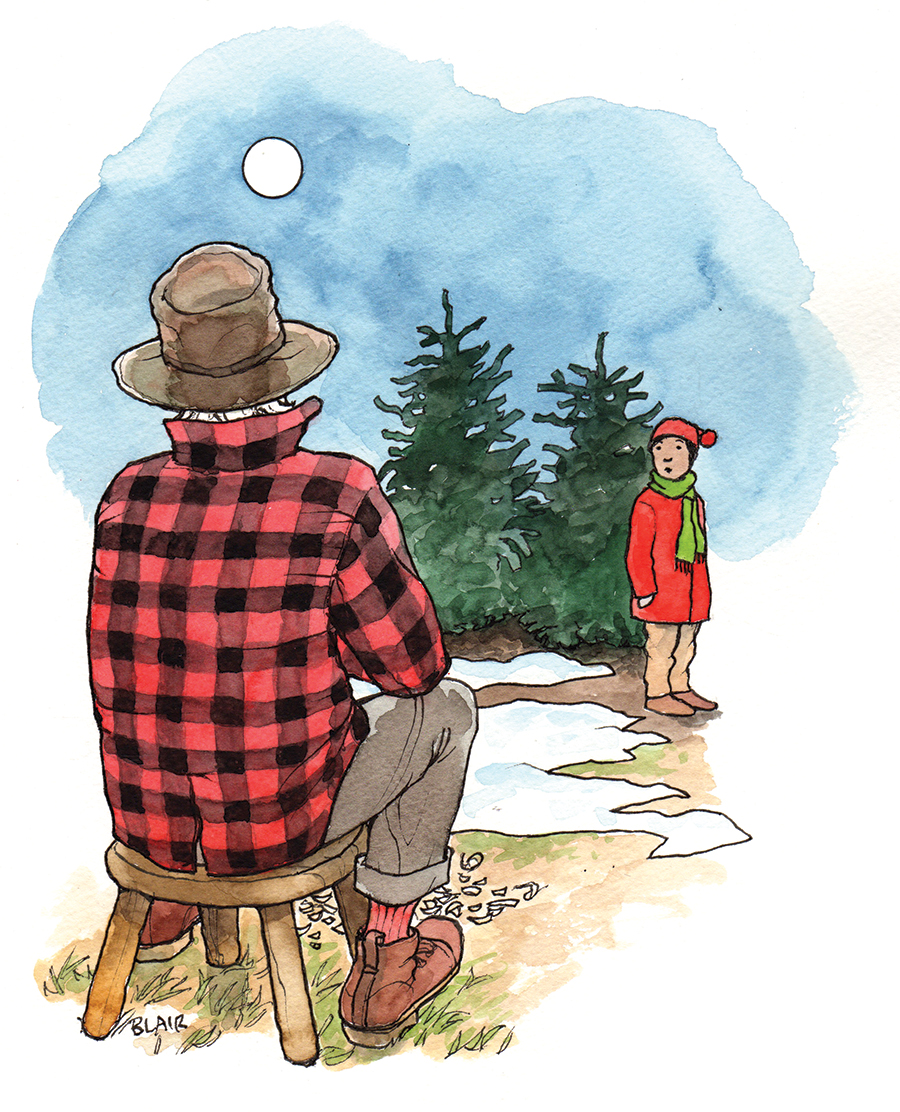
She remembered, too, how the tree always seemed to brighten their small home. Before putting on the homemade decorations, her family would sit and admire their tree just as it was, and her father would say how it reminded him of beauty and hope for a new beginning. Sarah’s heart swelled with joy as she thought about those happy days. But then, as the sleigh disappeared toward the center of the village and the sound of the bells faded into the cold night, she was brought back to the harsh reality that, for her family, times had changed.
Sarah had always believed her father when he took her on his knee and told her that they were the richest family in the village. It was only as she grew older that she realized how terribly poor her family really was. For some years her father had not been well and was barely able to keep a steady job. Last Christmas, as a young lady of 9, she began to see things as they were. Her father had grown sicker and hadn’t worked since early summer.
One night, when her parents thought she was asleep, Sarah heard her mother say to her father that they simply could not afford a Christmas tree that year. There was not even enough money to feed and clothe the children, and certainly not a penny to spare for anything so frivolous as a tree. Sarah’s mother was as practical as her father was hopeful. It was not that she loved her family any less. In fact, it was her intense love for her family that caused her to worry so much. That night, through a crack in the door, she saw her father put his arm around her mother and, in his usual cheerful way, comfort her. Sarah thought she heard him say something about a miracle, but that only seemed to make her mother cry more.
Still, they did manage to have a tree that year. Yes, it was the smallest one ever, but Sarah’s father brought it home with such a show that it seemed to be the grandest yet. He told the family again of how important the Christmas tree was — a reminder of how something small and humble can bring joy and hope into the world.
That night, Sarah saw tears in her mother’s eyes. It was to be the last Christmas the family would have with their father. In the early spring he was overcome by his illness, and they buried him among the daffodils where the valley gently rises toward the mountains.
That seemed like such a long time ago now, and yet there were times when Sarah still looked up expecting to see her father come through the door. She wondered what the first Christmas without him would be like. She was 10 now, and she knew her mother was depending on her to be grown up and brave. But her brother, John, who was only 5, still didn’t really understand that his father would not be home for Christmas. Their father had always managed to provide them both with a small toy at Christmas, and it hurt her to think of John’s disappointment because there would be nothing this year. Most of all, she couldn’t bring herself to accept that there would be no Christmas tree.
Sarah had a blend of her mother’s practicality and her father’s belief in the impossible. Though her mother hadn’t mentioned it, Sarah knew she couldn’t afford to buy a Christmas tree this year. Sarah didn’t resent this. Her mother worked hard in the nice homes of the village to provide for her children. She knew that the money her mother made would barely be enough to see them through the long, cold winter. Still, her father’s side of Sarah would not let her give up. She believed he would have found a way. He would have continued to hope.
Sarah’s school was at the other end of the village from her home, and the walk took her through the center of town, along the streets with delightful store windows, past the village square, and finally into the part of town with the grandest, loveliest homes. She always enjoyed the walk, but never so much as at Christmastime, when the stores were filled with wonderful gifts, the homes beautifully decorated and the village square alive with Old Sam’s freshly cut Christmas trees.
On her way home from school, Sarah paused to look in the store windows at the toys, the lacy dresses, bright ribbons, jars of candy and baskets of fruit. For a moment, she allowed herself to dream of having such nice things, but quickly stopped, knowing there would be no toys or fancy dresses this year. Sarah did, however, have a way to surprise her brother. She had five pennies and she planned to buy some candy and fruit to put in John’s stocking. It was still four days until Christmas, and she decided to wait as long as she could in the hope that the prices might be lower and her pennies would buy more.
When Sarah arrived in the square it was crowded with fine sleighs as the village families carefully inspected each tree to make sure they would have the right one for them. In a far corner, Old Sam sat on a log beside a small fire. He didn’t seem to notice or care what was going on around him. In one hand he held a carving knife and in the other a pine branch. A pile of wood shavings surrounded his feet. He rarely spoke to anyone, and only looked up from his whittling when someone was ready to buy their tree.
Sarah felt as though she was in a fairyland, breathing in the fragrance of the trees as she walked between the rows. She inspected each tree with great care, as though she, too, was making the all-important decision of which one to take home. Finally, she made her decision. She selected the most beautiful tree in the square and, in her imagination, pretended to take it home to her family. She knew it was silly to dream, and yet somehow she believed it was possible until a family walked up and announced that the tree — her tree — was the one for them. She stood silently fighting back tears, and watched her tree being taken away.
Before she realized it, an hour had passed and the tall pines were casting long shadows across the square. As Sarah began to turn for home, she suddenly had the feeling that someone was looking at her. She turned quickly, and her eyes met those of Old Sam. There was no expression on his face; he simply sat and looked at her through his gray eyes. She turned to see if there was someone behind her, but realized she was all alone.
When she looked back at him, he had gone back to his whittling. It made her so self-conscious, she ran for home, nearly tripping over a small tree. It was so small that she hadn’t even noticed it before. And, as she glanced at it for the first time, she thought it looked rather pitiful and hardly could be called a Christmas tree at all. “What a silly-looking thing you are,” she said. And she raced all the way home.
When she returned to the village square the following day after school, Sarah was surprised to find so many trees already sold, taken to homes throughout the village. Even so there were still many nice, freshly cut trees left, and Sarah inspected each with great care. Again she let her imagination wander back in time. She remembered how her father looked at her and how he seemed to delight in her excitement as she studied each tree. The dream seemed so real that, for a moment, Sarah thought she could feel her father’s gaze. But it was Old Sam who was looking at her.
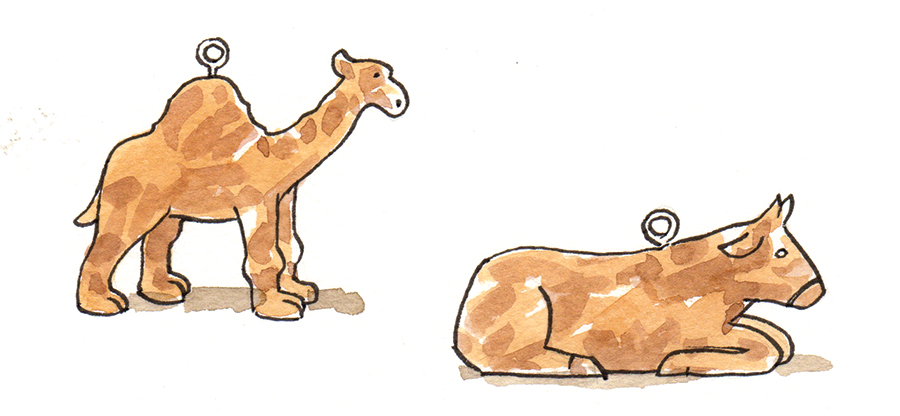
She shifted her eyes slowly and for a few seconds met the eyes of the old man sitting on the log. Sarah was certain she saw a brief smile. His weathered face behind the white beard seemed different that day, and Sarah had the feeling he was looking at her the same way her father once had. Old Sam sat silently for a moment and then, gesturing toward a tree some distance away, he said, “Have you looked at this one?”
When she turned, Sarah saw the little tree that she had nearly tripped over the day before. Sarah’s mother had taught her to always tell the truth, but she didn’t want to hurt the old man’s feelings. It was simply not a proper Christmas tree. She stood there for a moment looking at the little tree and trying to think what to say. But the problem solved itself, for when she looked back, Old Sam had stepped away to help another customer.
The following day was the last day of school before Christmas. There was the usual holiday excitement in the air as her class let out. Most of the children hurried home, anxious to be with their families and to enjoy their trees, look at the beautifully wrapped gifts and sample all those delicious things to eat. But Sarah went back to the village square.
When she arrived, there were only two trees left — a medium-sized one and the funny looking little tree. The old man was talking to the last family in the square. Sarah wished with all her heart that the family would pick the little tree, though she realized how unlikely that was. Sure enough, they selected the larger one. She stood there as Old Sam took their money and put the tree in the family’s sleigh, and she watched them disappear down the snowy lane. Suddenly, Sarah realized that she was all alone with the old man and the last Christmas tree.
Old Sam returned to his log by the fire and resumed his whittling, and she walked over to the little tree. For the first time, she looked closely at it. She still thought it was rather pitiful. It was so small, and the trunk was noticeably bent, and she wished the few little boughs were arranged better. Still, it was a real tree and it did have the same wonderful fragrance as the others, and she thought of how her father would have made it look grand by bringing it home with such a show.
Sarah felt the five pennies in her coat pocket. Then she swallowed hard, mustered up all her courage and walked over to the old man. In her most adult, business-like tone, she asked, “How much is that one?” Old Sam looked up into her eyes and then over at the little tree. He seemed to study the tree for a long time, staring beyond it, as though his thoughts were far away from the village square. Then he blinked his eyes and cocked his head and asked, “What do you have?”
“Five pennies, sir,” she replied.
“That will do,” he said with a serious nod.
It was everything she had. Sarah felt the coins in her pocket and tried to think which was more important for John — to have a gift on Christmas or to have a tree. It was such a hard decision, too hard for a 10-year-old girl. Finally she told Old Sam that she would have to go home and think it over. He gave no response, looked down and resumed his carving. Sarah was afraid she might have hurt the old man’s feelings and she stood there for a moment trying to think of what else to say. But it was getting late and she had to go home or her mother would worry.
Sarah kept thinking about the old man as she walked home. After supper, she asked her mother if she knew anything about him. Her mother thought for a moment, remembering what her own parents told her once.
“When Samuel Cross was a young man,” she began, “he and his wife lived here in the village. After many years of marriage, they had a child — a girl. She was a gentle child with beautifully delicate features, and she was loved by everyone in the village. But she was very small and frail and, because she was crippled, her father carried her wherever they went. He seemed to love doing this, since the child was the joy of his life. Then one winter, when she was about your age, Sarah, the little girl passed away. Her mother was so grief-stricken that she too died of a broken heart. Old Sam went up into the mountains and has lived there ever since, returning to the village only to sell his trees.”
Sarah understood why the old man looked at her the way he did, for it was the same way her father once looked at her. At that very moment Sarah resolved that she should buy the tree. In fact, the more she thought about it the more it seemed the little tree had always been meant for her and John, and she wanted it more than any Christmas tree she could ever remember. She wanted to run back to the village square and buy it right then, but her mother told her it was too late and that she would have to wait until morning.
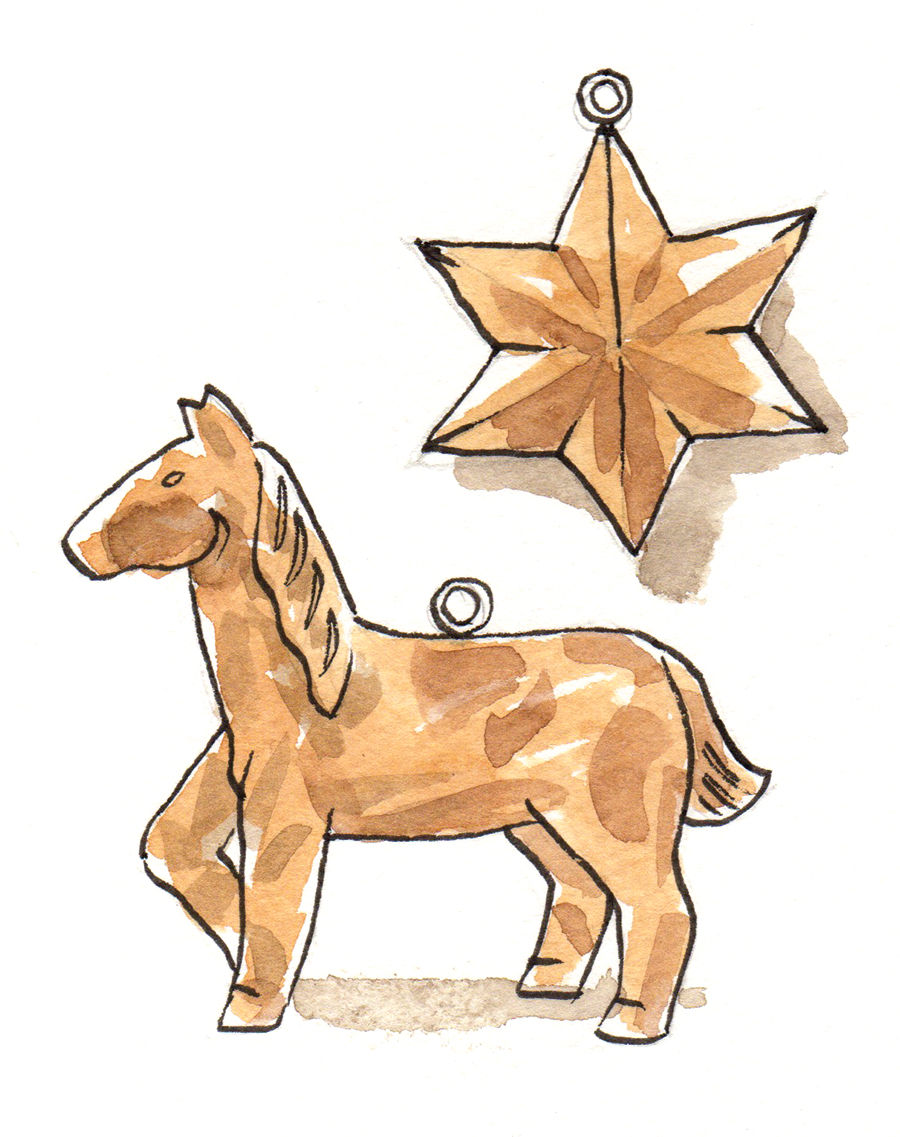
That evening, Sarah made Christmas decorations out of pieces of paper and, as she fashioned each one, she thought of how lovely they were going to look on her tree. She thought of the happiness it would bring Old Sam to have someone share his love for the little tree. Sarah was so excited she had trouble falling asleep. When morning finally came, it was the day before Christmas.
She was up at dawn and hurried to finish her chores. After a bowl of warm cereal and a glass of milk, Sarah was off for the village square. She ran most of the way and when she could run no more, she walked as fast as her legs would carry her. Her anticipation mounted as she reached the top of a hill where she could look down into the village. But, when she reached the summit, her heart sank like a great weight — the village square was empty.
She stood motionless for a moment, then hurried down to the square, hoping upon hope. Maybe Old Sam had slept late and would be coming along soon with her tree. But what if someone else already bought it? She couldn’t bear to think of it.
She stood in the snow all morning watching for Old Sam. By noon she realized he wasn’t coming. She wanted to hide someplace and cry, but knew that her father would have wanted her to be brave.
After a while, Sarah remembered that she still had her five pennies, so she left the square and went to the general store. Even though it was Christmas Eve, the money didn’t go as far as she had hoped. Still, she was able to buy a few peppermint sticks and an orange for John. And so, with her candy and fruit, Sarah went home.
That night, their mother sat on the side of the bed in which both Sarah and John slept. She tried to remember how her husband used to tell the Christmas story every Christmas Eve. Sarah listened carefully and once again felt the warmth that the story always brought her, and she lay there for a while trying to be thankful for God’s gifts. But she was only a little girl and it was the first Christmas without her father, and the disappointment of the day still lay heavily upon her heart. She cried quietly so as not to wake John and soon fell asleep herself.
Sarah was up early on Christmas morning. The world somehow looked different — more special — on Christmas day. So, while her mother and John were sleeping, she filled John’s stocking, then dressed and went to the front door to see how this day would look.
Sarah opened the door and the morning sun bounced brightly off the snow. Her eyes burst wide open when she beheld a sight that took her breath away. There, in her front yard, on a beautiful blanket of new fallen snow stood a tree — her tree!
Sarah wanted to scream for joy, but her heart was pounding so hard she could barely get her breath. As she began walking toward the tree, she saw that it was decorated with many delicate wooden carvings — dolls, toy soldiers, wagons, animals and on and on. Each was made of pine, and some looked like they had been freshly carved, while others seemed weathered, as though they had been collected over many years. On the bottom of each carving, were the initials S.C.
Sarah was startled by a holler and turned to see John running toward the tree and her mother standing in the doorway. The young boy danced around the tree, looking at all the toys. He took a truck from one of the boughs and, when he saw the initials, he exclaimed with total conviction, “Santa Claus!”
Sarah started to explain, but then saw her mother’s smile and heard her say, “Why, sure enough.”
Many Christmases have since come and gone, and Sarah has had children and grandchildren of her own. Many Christmas trees have stood in her home. Some have been large and lovely, but none have ever been so beautiful nor stayed so dear to her heart as the little tree that taught her that true happiness does not come from things large and grand, but through humble gifts, given with love. PS
Bruce Shields is a retired ophthalmologist who spent his career at Duke and Yale universities in patient care, education and research. He lives with his wife, Sharon, in Burlington, North Carolina.




